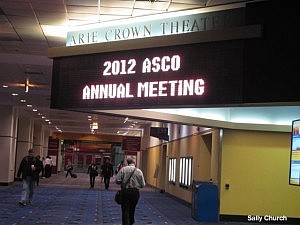Overcoming drug resistance in lung cancer
On the final day of the annual 2013 meeting of the American Association for Cancer Research (AACR) in Washington DC, Jeffrey Engelman (MGH) hosted an excellent plenary session on “Cancer Evolution and Resistance” with a series of superb talks not only from himself, but also Neal Rosen (MSKCC), Todd Golub (Broad Institute) and René Bernards (Netherlands CI).
If this session is included in the webcast, I would highly recommend watching the whole thing several times, as it was one of the meeting highlights for me. Despite being on the very last day, the large hall was pretty packed and well worth waiting for. You can check availability of the AACR 2013 webcast talks here.
I’m going to focus on some of the specifics in NSCLC from Engelman’s talk for this update.
Where are we in the quest to improve outcomes in lung cancer?

Jeff Engelman, courtesy of MGH
Engelman discussed the basics of what we know about adaptive resistance to TKI therapy in solid tumours – most of them (EGFR and ELM4-ALK in lung, BRAF in melanomas, HER2 in breast, and cKIT in GIST) typically being in the range of 8-11 months, with only GIST seeing an impact for nearly 2 years (20 months).
Thus we can see that the resistance develops over time as mutations and amplifications in the tumour evolve in adaptation to the initial efforts to inhibit the target. Indeed, approx. 50% of EGFR lung cancers develop the T790M mutation, while ~33% of resistant ELM4-ALK cancers show new mutations (e.g. L1196M, G1269A and others).
The development of these changes essentially serves as a way to bypass tracks and and continue to allow downstream signalling of PI3K and MEK to occur, thereby driving growth and cell survival. What then happens is a myriad of other pathways become activated to help drive signalling, for example MET, HER2/HER3, IGF1R etc in EGFR driven cancers and EGFR and cKIT amplification in ALK lung cancers.
As an analogy, think of this process like a road traffic system – if the route into New York from New Jersey was cut off at the Holland Tunnel, so traffic would increase to the Lincoln Tunnel or Verrazano Bridge and if those were cut off, traffic would then flow onto the George Washington Bridge, as it adapts and seeks new escape routes from the original destination.
Eventually, the cancer evolves further with defects in growth arrest and apoptosis, as seen with transformation from NSCLC to SCLC in some patients with EGFR cancers, and even changes in the microenvironment through epithelial mesenchymal transition (EMT) and loss of BIM.
The key question is what can we do about overcoming or delaying resistance?
One strategy would be to evaluate more potent inhibitors e.g. LDK378 instead of crizotinib in ELM4-ALK cancers. Another might be to explore logical combinations to address shutting down the bypass tracks. A third might be to add in a new inhibitor to target the specific mutations that evolve e.g. T790M inhibitor in the case of EGFR driven cancers when it appears.
Some of these trials are already underway and we should have more data soon.
Another way, as we saw with the last post on metastatic melanoma, is to identify mechanisms of resistance using laboratory models and lab specimens. This approach can potentially lead to more rational drug development in the clinic. Traditionally, scientists have induced resistance in mice, looked for the mechanisms (a process that can take 1-2 years), validated them in lab samples of patients, and then treated with a new treatment strategy.
This process is obviously time consuming though and not every patient can wait that long for the answer. Engelman then explained how they are looking at ways to streamline the process in Boston. After the mouse resistance experiments are completed, they have added in a drug combination screen to look for logical treatment strategies i.e. what can be added to the original drug to overcome resistance?
A very elegant example was given for EGFR lung cancer where they evaluated 78 test drugs in a screen with and without gefitinib to determine those which led to cell death. Other examples were given for ELM4-ALK cancers.
The screen results suggested that most of the resistant models produced 3-6 hits. These might include adding a MET inhibitor to an EGFR inhibitor in EGFR mutant cancer, an EGFR inhibitor in MET amplified cancers and a SFK inhibitor in the case of ELM4-ALK cancers, for example.
These results are still early, but they do look very promising. Validation studies are still needed, but early studies they performed suggested that the hits are indeed showing efficacy in vivo. A preclinical example for this concept was shown in vivo by adding ABT-263 (Bcl2 inhibitor) to gefitinib and seeing first a rise in tumour growth with the EGFRi and then a large drop in volume when either ABT-263 or AZD6244 (MEK) was added.
Based on the exciting initial concepts in animals, they are now moving to patient derived models since next generation sequencing (NGS) can help identify the mechanisms of resistance and combined with the drug combination screens, we may see more individual level treatments for patients on a case by case basis. These might be based on large scale (over 100 cell lines) testing derived from resistant biopsies to identify effective combinations and match them to the relevant biomarkers. It sounds easy and obvious, but few centres are doing this in practice.
This is true personalised medicine in action.
It is also pretty exciting to me as we know that cancer, even in different patient tumours, is very heterogeneous and requires a more personalised rather than a one size fits all approach. As Engelman observed,
“Heterogeneity of resistant clones within individual patients may pose additional challenges to overcome resistance.”
The second half of his really excellent talk focused on the use of sequential biopsies in patients to explain the heterogeneity and how it can lead to transformation from NSCLC to SCLC and back again in response to treatment with an EGFR inhibitor. That’s an in-depth discussion for another day though, but suffice to say it was a fascinating topic.
And finally…
I can see these novel and applied techniques eventually moving very fast and adopted in top level Academic centres where they have the resources and knowledge to marry basic and translational research with clinical practice in early stage trials, but for many Community or even regional Academic physicians, this will be virtually impossible without referral of patients to clinical trials in the Academic centres, at least for now.
Ultimately, we will see more improvements in treatment for lung cancer when we figure out not only the targets, but also how to overcome adaptive resistance, add logical new combinations, and select future treatment based on biopsies as the tumour evolves its response to each line of therapy. Treatment will essentially need to be chosen on an individual patient basis in the long run by evaluating adaptive resistance to each new combination over time.
The idea that we can use mouse models and drug combination screens with sequential patient biopsies to better understand the adaptive response to therapy over time is not new but few have managed to put processes and strategies in place to make this happen in real time. Patients often can’t wait 2 years or more for a new combination trial to open, but the Boston approach is very promising and I’d like to applaud all those at the Boston group (MGH, Dana-Farber, MIT/Broad etc) for their groundbreaking work in this field. Keep your eyes peeled for more updates in this exciting area of research!
 It’s been a crazy busy time since the
It’s been a crazy busy time since the 



 In other words, it’s too expensive and the NHS doesn’t want to pay the £80K ($120K) sticker price. This news is no great surprise given the cost-benefit ratio when considering that there is no way to tell who might benefit most from treatment upfront.
In other words, it’s too expensive and the NHS doesn’t want to pay the £80K ($120K) sticker price. This news is no great surprise given the cost-benefit ratio when considering that there is no way to tell who might benefit most from treatment upfront.